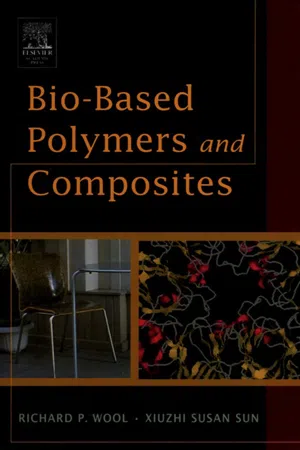
- 640 pages
- English
- ePUB (mobile friendly)
- Available on iOS & Android
Bio-Based Polymers and Composites
About this book
Bio-Based Polymers and Composites is the first book systematically describing the green engineering, chemistry and manufacture of biobased polymers and composites derived from plants. This book gives a thorough introduction to bio-based material resources, availability, sustainability, biobased polymer formation, extraction and refining technologies, and the need for integrated research and multi-disciplinary working teams. It provides an in-depth description of adhesives, resins, plastics, and composites derived from plant oils, proteins, starches, and natural fibers in terms of structures, properties, manufacturing, and product performance. This is an excellent book for scientists, engineers, graduate students and industrial researchers in the field of bio-based materials.* First book describing the utilization of crops to make high performance plastics, adhesives, and composites* Interdisciplinary approach to the subject, integrating genetic engineering, plant science, food science, chemistry, physics, nano-technology, and composite manufacturing.* Explains how to make green materials at low cost from soyoil, proteins, starch, natural fibers, recycled newspapers, chicken feathers and waste agricultural by-products.
Frequently asked questions
- Essential is ideal for learners and professionals who enjoy exploring a wide range of subjects. Access the Essential Library with 800,000+ trusted titles and best-sellers across business, personal growth, and the humanities. Includes unlimited reading time and Standard Read Aloud voice.
- Complete: Perfect for advanced learners and researchers needing full, unrestricted access. Unlock 1.4M+ books across hundreds of subjects, including academic and specialized titles. The Complete Plan also includes advanced features like Premium Read Aloud and Research Assistant.
Please note we cannot support devices running on iOS 13 and Android 7 or earlier. Learn more about using the app.
Information
OVERVIEW OF PLANT POLYMERS: RESOURCES, DEMANDS, AND SUSTAINABILITY
Publisher Summary
Table of contents
- Cover image
- Title page
- Table of Contents
- PREFACE
- ABOUT THE AUTHORS
- Chapter 1: OVERVIEW OF PLANT POLYMERS: RESOURCES, DEMANDS, AND SUSTAINABILITY
- Chapter 2: PLANT MATERIALS FORMATION AND GROWTH
- Chapter 3: ISOLATION AND PROCESSING OF PLANT MATERIALS
- Chapter 4: POLYMERS AND COMPOSITE RESINS FROM PLANT OILS
- Chapter 5: COMPOSITES AND FOAMS FROM PLANT OIL-BASED RESINS
- Chapter 6: FUNDAMENTALS OF FRACTURE IN BIO-BASED POLYMERS
- Chapter 7: PROPERTIES OF TRIGLYCERIDE-BASED THERMOSETS
- Chapter 8: PRESSURE-SENSITIVE ADHESIVES, ELASTOMERS, AND COATINGS FROM PLANT OIL
- Chapter 9: THERMAL AND MECHANICAL PROPERTIES OF SOY PROTEINS
- Chapter 10: SOY PROTEIN ADHESIVES
- Chapter 11: PLASTICS DERIVED FROM STARCH AND POLY (LACTIC ACIDS)
- Chapter 12: BIO-BASED COMPOSITES FROM SOYBEAN OIL AND CHICKEN FEATHERS
- Chapter 13: HURRICANE-RESISTANT HOUSES FROM SOYBEAN OIL AND NATURAL FIBERS
- Chapter 14: CARBON NANOTUBE COMPOSITES WITH SOYBEAN OIL RESINS
- Chapter 15: NANOCLAY BIOCOMPOSITES
- Chapter 16: LIGNIN POLYMERS AND COMPOSITES
- INDEX